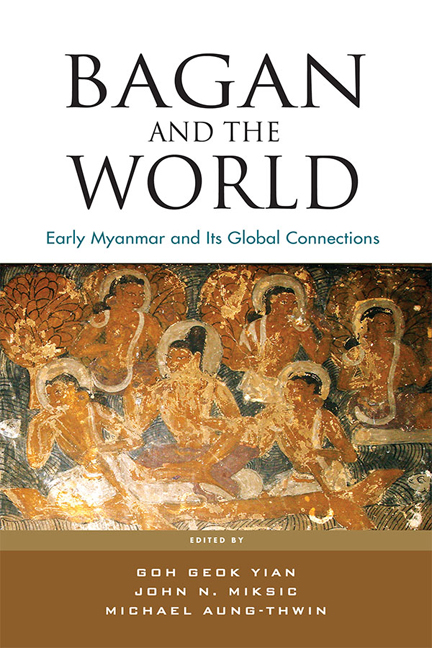Book contents
- Frontmatter
- Contents
- Preface
- Contributors
- 1 Keynote: The Myth of “Splendid Isolation”
- 2 Analysis of Construction Technologies in Pyu Cities and Bagan
- 3 Khraung-kaik Pitaka-taik: 16th-Century Repositories for Buddhist Scriptures in Mrauk-U
- 4 Religious Symbols as Decorations on the Sikhara of Ancient Monuments in the Late Bagan Period
- 5 The Viṣṇu on Garuḍa from the Nat Hlaung Kyaung Temple, Bagan
- 6 A Thousand Years before Bagan: Radiocarbon Dates and Myanmar's Ancient Pyu Cities
- 7 Ta Mok Shwe-Gu-Gyi Temple Kyaukse and Bagan
- 8 Silver Links! Bagan–Bengal and Shadowy Metal Corridors: 9th to 13th Centuries
- 9 Positioning Bagan in the Buddhist Ecumene: Myanmar's Trans-Polity Connections
- 10 Orthogeneity, Settlement Patterns and Earthenware Pottery Distribution in Bagan
- Index
- Miscellaneous Endmatter
6 - A Thousand Years before Bagan: Radiocarbon Dates and Myanmar's Ancient Pyu Cities
Published online by Cambridge University Press: 01 February 2018
- Frontmatter
- Contents
- Preface
- Contributors
- 1 Keynote: The Myth of “Splendid Isolation”
- 2 Analysis of Construction Technologies in Pyu Cities and Bagan
- 3 Khraung-kaik Pitaka-taik: 16th-Century Repositories for Buddhist Scriptures in Mrauk-U
- 4 Religious Symbols as Decorations on the Sikhara of Ancient Monuments in the Late Bagan Period
- 5 The Viṣṇu on Garuḍa from the Nat Hlaung Kyaung Temple, Bagan
- 6 A Thousand Years before Bagan: Radiocarbon Dates and Myanmar's Ancient Pyu Cities
- 7 Ta Mok Shwe-Gu-Gyi Temple Kyaukse and Bagan
- 8 Silver Links! Bagan–Bengal and Shadowy Metal Corridors: 9th to 13th Centuries
- 9 Positioning Bagan in the Buddhist Ecumene: Myanmar's Trans-Polity Connections
- 10 Orthogeneity, Settlement Patterns and Earthenware Pottery Distribution in Bagan
- Index
- Miscellaneous Endmatter
Summary
There are now sufficient radiocarbon dates for the walled cities of Halin, Beikthano and Sriksetra to suggest that they were all functioning by the early centuries ce. In the light of the new data, approaches to the periodization and interpretation of Myanmar's early urban system may need to be modified.
If you want to know the exact date of an ancient object or structure, find an inscription. In the 11th–13th century Bagan period, stone inscriptions give the founding year of dozens of pagodas. Some inscriptions, motivated by an urge to commence building at an auspicious moment, go so far as to nominate the day, hour or even minute when construction began (see, for example, Luce 1932). From Bagan onward, these absolute dates have provided a vital chronological framework for historical and archaeological analysis. When monks and scholars sat down in King Bagyidaw's “Glass Palace” in 1829 to try to bring together the often contradictory narratives of earlier chronicles, pagoda histories and religious commentaries, they recognized the value of inscriptions for their dates as well as for their dedicatory content (Pe Maung Tin and Luce 1923).
A “scientific” date, generally from carbon, can also provide an accurate time for a past event, but the time is within a range of centuries, not a specific year. However, radiocarbon dates can also go back many thousands of years before inscriptions. So far there have been relatively few samples from Myanmar tested to provide carbon dates, but the results of carbon dating so far show, among other things, that construction and other economic and cultural activity was taking place between the 1st and 3rd centuries ce at Sriksetra, Halin and Beikthano (figure 6.1). These date ranges help provide a framework within which we can view changes in art styles, palaeography, architecture and expressions of religious ideas in text or sculpture during the early urban period, before inscriptions appear.
Radiocarbon Dating
Radiocarbon dates tell us when the material being tested was alive. The material is usually wood which, before it rotted away in the ground, was converted to charcoal by burning and was thus preserved. During its lifetime the wood took in an isotope, Carbon-14 (written as 14C).
- Type
- Chapter
- Information
- Bagan and the WorldEarly Myanmar and Its Global Connections, pp. 88 - 121Publisher: ISEAS–Yusof Ishak InstitutePrint publication year: 2017

